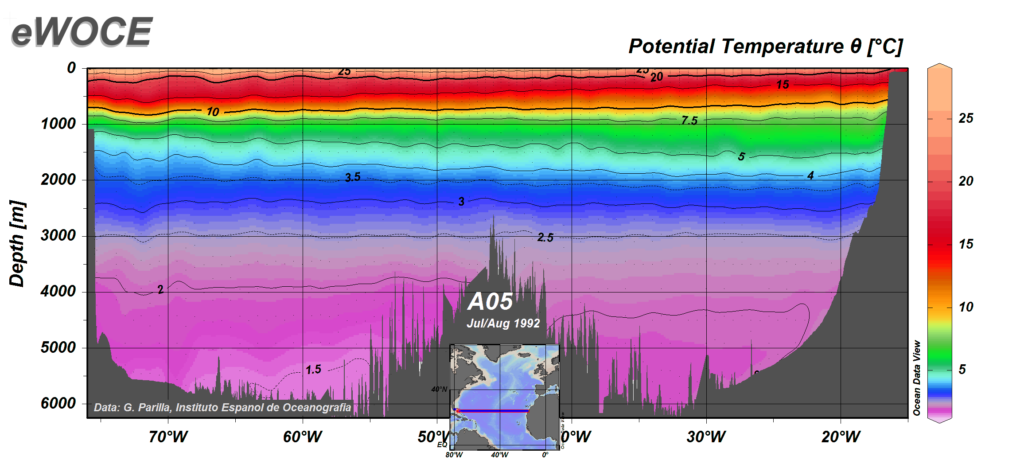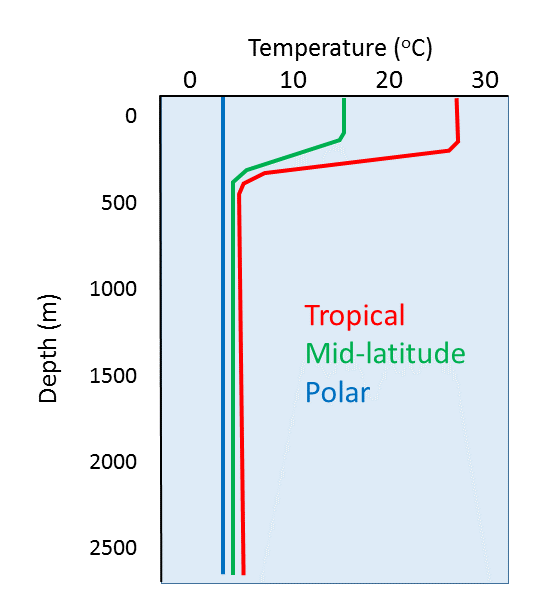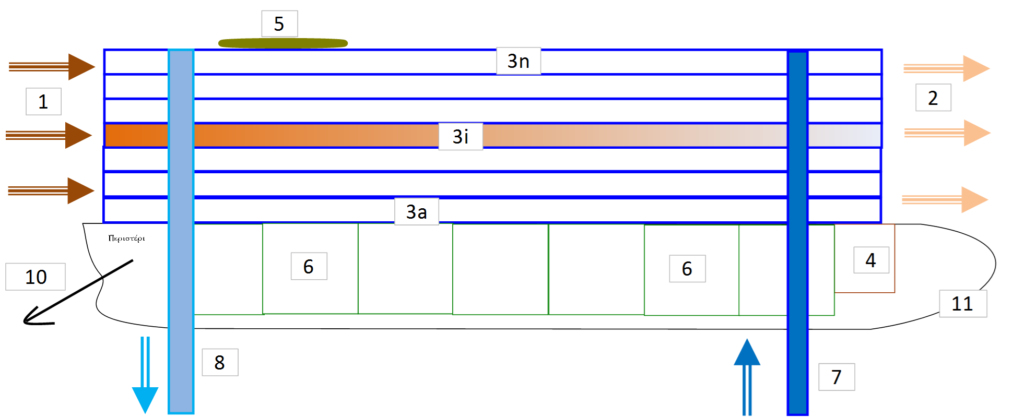Keywords: Tropical seas fresh water production thermocline layer condenser hot humid air
General
Land resources in water are shrinking from year to year with the increase of the world population, improved hygiene and comfort as well as the constant development of industry and agriculture. Various means have been implemented around the world to capture water vapour in arid zones using cooled nets or walls, droplets suspended in the air or by condensing the water vapour contained in the air passing through the blades of a wind turbine, the air being cooled by a cooling cycle operated by the wind turbine. However, these different means produce very little water, a few hundred litres a day.
Nevertheless, huge water resources, still unused, reside in the atmosphere, especially in the warm airs of the tropics. However, these resources are only accessible under certain conditions: the air must be close to its saturation point in water, present a high temperature (high fraction of water vapour) and move at relatively high velocity.
Water temperature in oceans
Generally ocean temperatures range from about -2o to 30o C. The warmest water tends to be surface water in low latitude regions, while the surface water at the poles is obviously much colder. Note that at equivalent latitudes, water on the eastern side of the ocean basins is colder than the water on the western side. This has to do with the pattern of surface currents. For ocean temperature distribution over the ocean see figure on following page: http://yvcharron.com/index.php/water-production/

Image from
INTRODUCTION TO OCEANOGRAPHY – Roger Williams University
Even though surface water can be quite warm, most of the water in the oceans is deeper, colder water, so that the average temperature of the entire ocean is about 4o C.
_

Image from
INTRODUCTION TO OCEANOGRAPHY – Roger Williams University
Temperature profiles vary at different latitudes, as the surface water is warmer near the equator and colder at the poles. In low latitude tropical regions the sea surface is much warmer, leading to a highly pronounced thermocline. Additionally, there is not much seasonal change in surface temperature in tropical regions, so there is little seasonal change in the profiles. In high latitude (polar) regions, there is little difference between the surface temperature and the deep water temperature, and temperature is fairly constant (and cold) at all depths. Polar waters therefore lack a strong thermocline, and as with tropical water, there is little seasonal change in temperatures. Mid-latitude temperate regions show greater seasonal fluctuations in surface temperature than the poles or the tropics; an 8-15o C difference from summer to winter in temperate zones, compared to only ~2o C in polar and tropical areas. In temperate regions, the surface water is much warmer in the summer and the thermocline is more pronounced compared to the winter months. But in the winter the thermocline is deeper at mid-latitudes than it is in the summer. This is because winter storms churn up the surface water more than occurs in the summer, creating a deeper mixed layer and thus a deeper thermocline.
_
Air characteristics over the ocean
This section will be completed later
_
The magnitude of the wind velocity is a particularly important parameter since it determines the amount of air flow rate, therefore water vapour flow rate, passing through condensing elements and determines also the feasibility of an operation of equipment based on the venturi effect (cooling of the air following its acceleration – dynamic condensation). This situation may be encountered in mid latitude where wind velocity is relatively high while the air temperature is intermediate between polar and equator temperatures.
Cooling of moist air can also be achieved by means of static condensers (no venturi effect). These condensers would be cooled down by pumping a relatively cold water in the thermocline layer located approximately 200 m below sea level. This situation may be encountered in low latitude (tropical seas) where the air temperature is relatively high and the wind velocity is relatively low.
_
Water production with condensers cooled down by thermocline water

Longitudinal view of a barge fitted with air condensers cooled by thermocline water: 1-Wind entrance; 2-Wind exit; 3a, 3i to 3n condensers stack mounted; 4-Utility; 5-Heliport; 6: Water storage; 7-Cooling water entrance from thermocline layer; 8-Cooling water exit to thermocline; 10-Anchoring; 11-Barge hull
_
In tropical seas the wind velocity is relatively low, rarely exceeding 5 m/s. Therefore a significant cooling of the air can not be obtained by the operation of venturi. However a relatively efficient cooling may be obtained by the use of condensers (3a, 3i or 3n) stack mounted on a sea barge with the warm humid air flowing inside the condensers (from 1 to 2) cooled down by the low water temperature pumped from the thermocline layer (7).

Longitudinal view of an air condenser (3i) cooled down by thermocline water: 7-Cooling water entrance from thermocline layer; 8-Cooling water exit; 9-thermocline water circulating inside condenser; 12-air deflectors enhancing air mixing; 13-Orifices for thermocline water entrance and exit; 14-condensed water drained towards water storage
_
An individual condenser (3i) appears like a tube with a diameter of the order of several meters and a length of the order of some tens of meters for permitting a sufficiently long residential time (thermodynamic kinetic) and air mixing enhancing the cooling of the warm humid air. Air mixing is provided by solid structures (9) deviating the internal flow from one side to the other (right – left and up – down) permitting an efficient air cooling.
Examples of fresh water production
This section will be completed later
To be reviewed : A mass of air passing through a 10,000 m2 section with a relative humidity of 100%, a temperature of 30° C, a velocity of 10 m/s and cooled by 10° C would allow the condensation of about 1,200 kg/s (ie 1,200 litres per second) of water vapour. With a, per capita, water consumption of 100 litres per day, approximately 1 million people could be supplied with fresh water by means of a single sail.